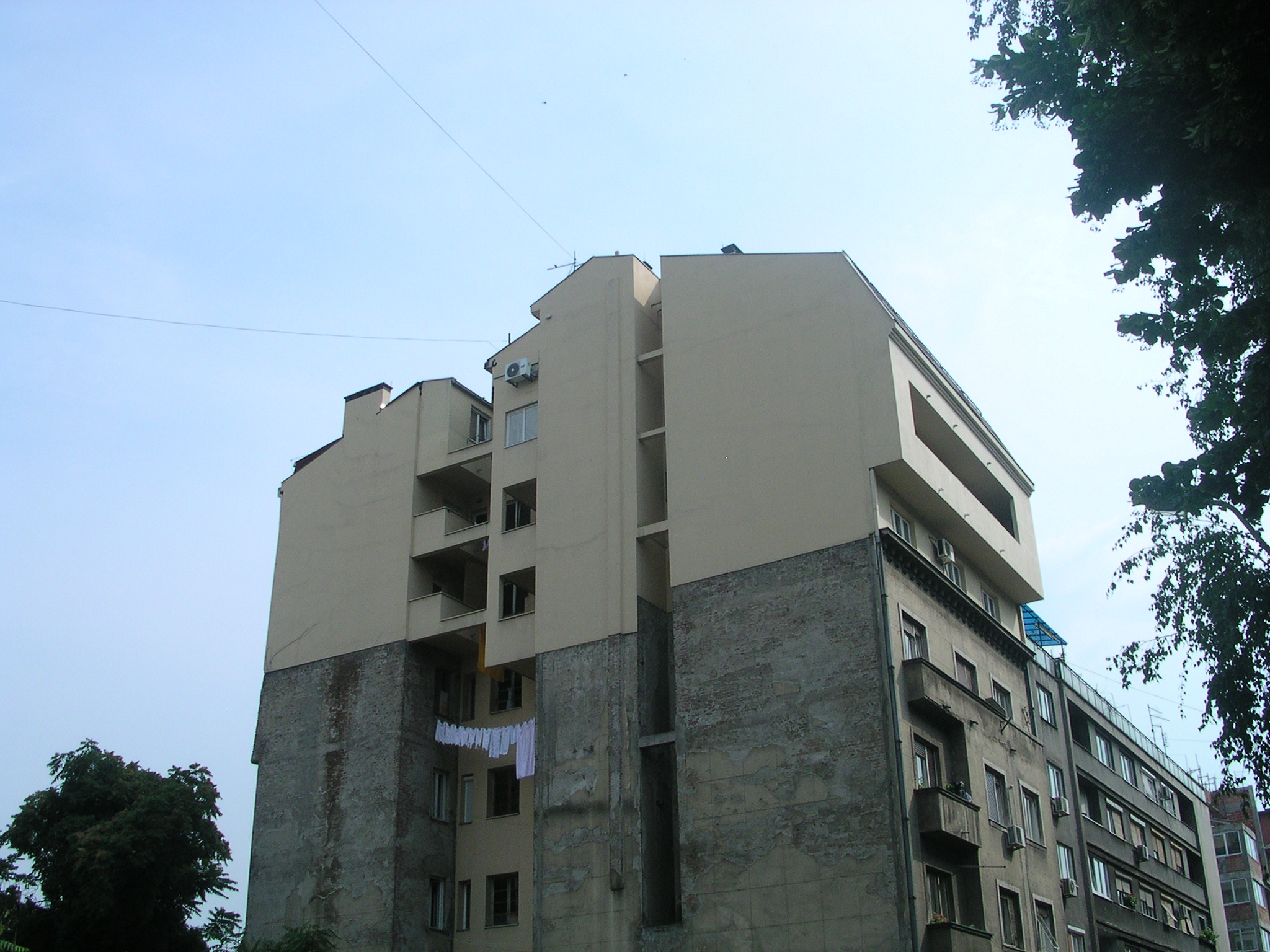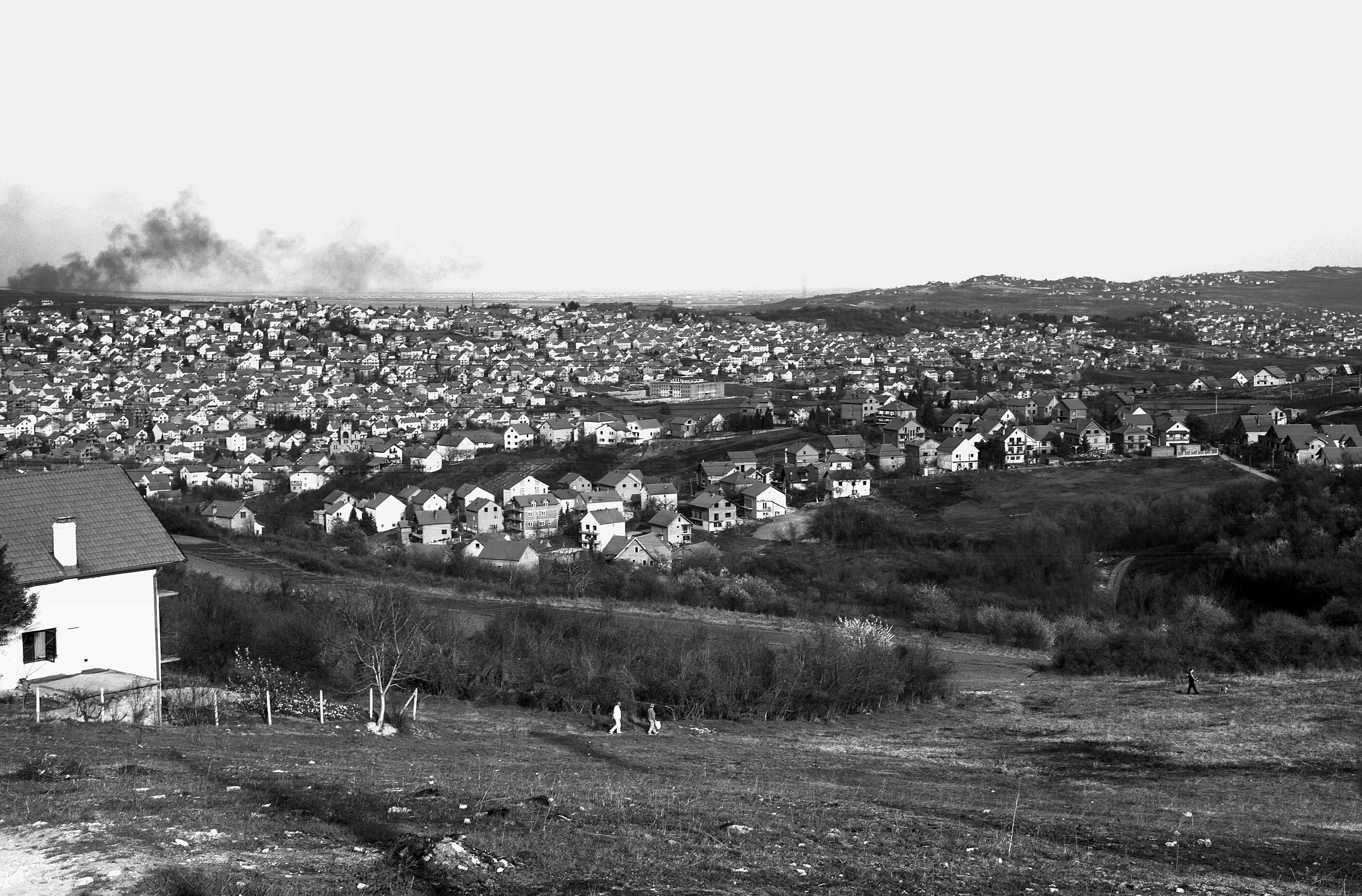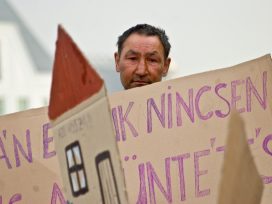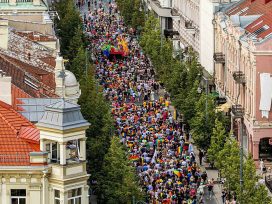
Roof extension in Belgrade. Photo: Sanja Stojanović (2007)
In the fall of 2017, an Instagram profile appeared entitled malo smo nadogradili (‘we extended just a little bit’), documenting rooftop extensions – or houses on top of houses – visible on the Belgrade skyline. Some are under construction, some have been completed, and some will never be completed. Many seem extravagant.
This marked a return of the roof extension to the public eye at a moment when the topic of construction without planning permission was again gaining attention. During the 1990s and early 2000s, the general consensus within the architectural profession was that the roof extension, together with the street kiosk, was the most obvious symbol of the city’s negative transformation. They were seen to have supplemented the informal settlements built on the outskirts without planning permission as the key example of people’s inability to follow regulations and the general disregard for architectural expertise. However, the cry for more regulation, meaning more involvement of architects, did not hinder the production of space in this legal grey area.
What professionals failed to notice, however, was the pivotal role played by kiosks, roof extensions, and other forms of extra-legal construction in Serbia’s informal economy in the 1990s. Even a small informal economy like that which existed in Serbia in the 1990s ultimately produces surplus value that needs to be absorbed, mainly into the built environment. Although initially a response to sheer necessity, the illegal construction of kiosks, roof extensions and other buildings simultaneously drove the urbanization needed to absorb surplus. As the surplus grew, so did its spatial manifestation, creating the perfect setting for romantic fantasies about the Balkans: crazy, bustling with life and empowering the individual with raw energy. To the eye of the outsider, kiosks and roof extensions were the ultimate proof that urbanization can be democratized and that ordinary people can take control over the production of city space and the city. The invisible hand of the market was overlooked entirely.
The demonization of spatial manifestations of the informal did not stop their proliferation. If anything, informal constructions grew in number and volume, until the economy stabilized in the 2000s and the extra-legal, its most obvious form, disappeared from the streets. That does not mean that legal grey areas are no longer used to produce space. On the contrary, the practice has become pervasive and increasingly serves to maximize extraction of private profit. While it is easy to focus on roof extensions, the issue around informality in Belgrade’s spatial development is a far more complex issue that must be considered in relation to the radical changes that society has undergone over the last seventy years, in the course of which the primacy of private property gave way to an experiment in societal property and then back again.
The terminology used in relation to informality in the Yugoslav context has been a point of debate among researchers. During socialism, the most dominant term was divlja gradnja (‘wild construction’). Since then, however, bespravna gradnja, meaning illegal or unlicensed construction (literally ‘right-less’), has been used more frequently. The terms ‘wild’ and ‘illegal’ are nevertheless problematic, since they either have a moral connotation or they obfuscate the problem. The urban historian Brigitte Le Normand argues for the use of the term ‘rouge construction’, stressing that during socialism the term ‘wild construction’ was used as a means to discredit political enemies:
Builders were characterized as social cases needing to be cared for and removed from public sight; speculators who should be disciplined and punished; nouveaux-riches who should be humbled. These were all cases of delinquency. Only in the case of exploited workers was it necessary to question the way in which the state functioned.
In the following, I prefer the term extra-legal, since it allows me to argue that certain building practices continued despite changes to the ideological and legal frameworks in which they took place. It also enables me to show that the informal has always existed in relation to the legal – not as its negation, but as its derivative. I will give an overview of the situation from 1930s until the present, focusing particularly on the period of informal development from 1960s to the 1980s, which was when laws regulating construction and property were most complex. Whether pertaining to property relations, building codes, urban requirements or other matters, these laws, in all their intentional or unintentional ambiguity, were translated into form. What was considered to be the informal built environment would serve as an optical device for seeing the invisible. As Bruno Latour writes, ‘to provide a piece of information is the action of putting something into a form’ What, then, can the form of the informal in Belgrade inform us about?
‘All of this is illegal!’
In the 1980s, when the construction of new social housing in Yugoslavia slowed down dramatically as the result of the recession and IMF imposed austerity, discussion about unauthorized construction as the symbol of rising inequality and the growing housing crisis was part of the public discourse. The impossibility faced by young adults coming of age in the 1980s of gaining a secure job and home of their own provided the sub-plot for many a film and TV series. One example is the series Zaboravljeni (‘The Forgotten Ones’), a pop-cultural product capturing society at a time when the transformation from late socialism to capitalism had already begun and the new class divisions were becoming obvious.
‘Phone, man? This place has no running water, no sewage system, no streets; this place doesn’t even exist on a map! All of this is illegal!’ This is the bitter reply of the high-schooler Danko, a resident of Kaluđerica, Belgrade’s largest and fastest growing extra-legal settlement in Yugoslavia, to a rich high-school friend asking to use the landline phone. The stark contrast between the domestic conditions of the two friends, one living in an expansive single-family house in an affluent neighbourhood, the other in an ‘unfinished building’ – a euphemism for a construction site – captures a divide which when the series was made was still considered an aberration, but few years later became a feature of the new capitalist system. Finally, Danko’s fictional TV family crumbles under the psychological pressure of life in a home that is permanently unfinished (due to lack of money) and constantly threatened with demolition, in an area where the reproduction of everyday life is difficult if not impossible (due to lack of basic infrastructure).
This kind of stress was mentioned in sociological surveys conducted in the area at the time. While the fear of demolition was real, however, people generally managed to have a peaceful and pleasant life. One of the first sociological surveys of Kaluđerica, Branislava Saveljić’s ‘Beogradska favela’ (Belgrade Favela), attempted to understand both the social structure and motivation of the people who, despite all the difficulties and stigma, built and settled there, as well as the economy supporting the construction of the settlement. The survey challenged the prevailing image of the illegal builders as being poorly educated and low-earners. Instead, it showed that Kaluđerica was much more diverse than expected, its population consisting equally of the highly educated, skilled workers, and those with only elementary schooling. The study also showed how some of the construction was supported by official bank loans, and that some of the houses were legally connected to the electric grid, thus challenging the assumption that Kaluđerica was entirely produced outside the system.

Kaluđerica, Belgrade’s largest and fastest growing extra-legal settlement in Yugoslavia. Photo: Luka Knežević-Strika (2012)
‘250 dinars and 10 days in jail’
But where did the idea come from that if people were building by themselves and without permits, they must automatically be poor? A short walk in one of the neighbourhoods would have shown otherwise, since most of the houses were large and solidly built. While the most were still lacking a facade to cover the red brick, which would become synonymous with this type of settlement, they were not a sign of destitution, nor even necessarily of poverty.
Zlata Vuksanović-Macura offers one interpretation for the source of this prejudice in her historical study of the living conditions of the poor in Belgrade during the interwar period. A capitalist monarchy at that time, Yugoslavia had insufficient housing provision for workers and poor citizens, who lived in homes described as dog kennels in the contemporary press. Even the middle classes had problems securing stable and affordable apartments. The only available option available to them was to rent on the private market, which was largely unregulated.
But lack of regulation was not the main issue. Far more problematic was the law preventing joint ownership of a building, i.e. ownership of an individual apartment, or a single floor. The law recognized only the ownership of the whole building, thus privileging the landlord class. Members of the lower middle-class and working class with funds at their disposal were turning to illegal construction on the outskirts of Belgrade as an alternative to life in substandard living conditions. There were even cases of landlords providing parts of bare plots with little or no infrastructure on which the poorest could build huts. The cost of breaking the law, if the building was within the limits of regulation, was ‘a fine of 250 dinars and 10 days in jail’, after which the building would be ‘legalized’. In addition to providing a secure and stable home for those prepared to risk the ‘fine and jail strategy’, the house would provide an additional source of income, since usually they would include a smaller separate unit that would be let to those less fortunate.
‘Have a house? Return an apartment!’
The abject living conditions of the poor and the housing shortage exacerbated by damage during WWII, followed by the immediate and persistent pressure of urbanization, led to a ‘right to housing’. being articulated as a key principle guiding the spatial development of the socialist Yugoslavia. Up until 1992 and the reinstatement of capitalism and private property, the Law on the Financing of Housing Construction stated that ‘Based on solidarity and reciprocity, organizations of Associated Labour and other self-managed organizations and communities, as well as society at large, must take action and create opportunities for every person to realize their need for housing, as well as the fundamental requirements for social security.’
The right to housing was part of the introduction of social property in Yugoslavia, a tool through which society would re-distribute and manage itself. The state’s role would be limited to providing a regulatory framework. Most factories and enterprises were socially owned, and their surplus was invested in the production of housing. Worker’s councils, the governing body within the factories, would make decisions on the extent of housing investment, based on need and available resources. Units were allocated according to ranking systems that included factors such as family size, length of employment, and level of education.
However, tying distribution of housing to permanent employment would prove to be one of the downsides of the Yugoslav system, in which unemployment was a constant predicament. Another problem was ‘market syndicalism’. Benjamin Ward argues that ‘because workers in labour-managed firms in Yugoslavia had the power to choose between new investment and individual incomes, they would limit the hiring of additional workers among whom the net profit would have to be distributed.’ Hence, while the right to housing was considered ‘a basic legal institution’, workers who had been granted this right preferred to vote not for the construction of more units but for investment into some other infrastructure, the most popular being holiday facilities in the mountains or on the Adriatic coast. Endemic corruption meant that people had permanent tenant’s rights for multiple units or kept the societal housing flat alongside a private house, which more often than not had been built extra-legally. In the 1980s, a campaign with the slogan ‘Have a house? Return an apartment’ was launched to encourage people who had acquired a private house to return the societally owned apartment for which they had a permanent tenant’s right.
The stark contrast between the housing built within the societal housing system and the that built extra-legally with private funds was underlined by the sheer materiality of the two processes: the concrete of the prefabricated modernist housing blocks versus manually laid red brick. This material divide was most visible in Belgrade, not only because of migration pressure, but also because official planning left little space for individual residential building. After all, the capital had to showcase the effectiveness of the ‘right to housing’ system. However, despite legislation introduced to curb extra-legal construction, as well as intermittent demolitions, the number of units built without permission rose slowly but steadily. Although officials would never admit it, extra-legal construction had its benefits, since it alleviated pressure from the already stretched societal housing system, as ‘a tolerated or overlooked supplement to modern city planning’.
Unauthorized construction was thus increasingly integrated into a system that officially was trying to curb it. Defining what was illegal about so-called illegal construction became problematic, particularly as it was often funded by official bank loans. As Saveljić writes, given the expense of obtaining construction permits legally from the state, migrant workers had no other choice than to build illegally. Internal migration from rural to urban areas was the main characteristic of the modernization and urbanization process Yugoslavia underwent after WWII. However, the term migrant can also be understood as the one who crosses the border in search for work, and resides, for a shorter or longer period of time, in another country. This raises a further issue: the connection between unemployment, migration and extra-legal construction.
‘It takes five years’ work abroad to save enough to buy the materials for a house’
Most research on Yugoslav system of workers’ self-management done at the time ignored the high rates of unemployment. This was present even during periods of economic growth, however became acute with the economic crisis in the 1970s and 1980s. The inability to produce and distribute sufficient housing, as well as the inability to even approach full employment, were among the fundamental paradoxes of Yugoslavia’s take on real existing socialism. Unemployment and insufficient housing were interconnected, not only because the workplace was the main access to housing, but also because all the members of the working collective took part in the decision about the redistribution of the surplus. The idea of hiring new workers was always juxtaposed with the number of new flats to be acquired and distributed, and other benefits that would have to be shared between more people.
After the market reforms in 1965, unemployment had already become an acute problem. In order to solve it, the state had to open its borders and export the unemployed. Special offices were established within the official state employment bureaus that would help people find employment abroad. There were two types of work placement available, which tended to differ in educational prerequisites: highly trained engineers and other professionals would often find temporary work in the non-aligned countries of Africa and the Middle East, mostly in governmental institutions through the UN’s network of technical support, while manual labourers, factory workers and carers found work in western Europe, usually in Germany, Austria, and Switzerland.
Extra-legal construction benefited from the export of unemployment. The new Gastarbeiter class became an important investor in ‘wild constructions’, either directly or through the remittances they sent home to relatives. As one migrant worker is quoted as saying: ‘There is an approximate tariff: it takes five years’ work abroad to help support the family and save enough to buy the materials for a house. The building the family do themselves.’ This flow of money into the extra-legal sector was also largely a result of the inability of the state to properly integrate the Gastarbeiter class. One of the major obstacles to integration was the systemic impossibility for migrant guest workers to actively participate in the system of social reproduction. Those who wanted to invest in housing in order to have a better home to return to during the holidays or after retirement were forced to do so extra-legally.
In order to fully understand the process of wild building prior to 1990, it is therefore important to look at its connection to unemployment and migration. However, the development of urban informality can also be understood in the context of the re-appearance of class divisions. Although Yugoslavia proclaimed the end of class struggle as the victory of the socialist revolution, market socialism and the liberalization of the Yugoslav economy were a fruitful ground for the re-emergence of class in Yugoslavia, especially the ‘red bourgeoisie’, i.e. the members of the growing techno-managerial class.
The red bourgeoisie was also not immune to the temptation of unauthorized construction. However, rather than using it as a solution to immediate personal housing problems, it was a way to acquire weekend homes, popularly dubbed as vikendica. The number of weekend homes increased from 1960s onwards, yet it was never precisely determined, since – according Karin Taylor – ‘a substantial number of holiday cottages remained unregistered or were constructed illegally and consequently failed to show up in official surveys.’ Yet although vikendica were built for a different reason than a primary family home without permit, both ‘displayed social inequality and spatial segregation’. According to Saveljić, by late 1980s it was possible to find examples of every possible species of informality in Kaluđerica.
Regulation as recognition and incentive
This brings us to the last question: how illegal was Kaluđerica in actual fact? The first constructions there were largely extra-legal. Available, arable land close to existing buildings would be bought and houses built, sometimes almost overnight, at other times painstakingly slowly. Self-builders often moved into their houses long before they were habitable. No plans whatsoever existed for building infrastructure and dozens of houses would often rely on just one public pipe for their water supply.
Yet Kaluđerica started to grow, and with it the leverage its inhabitants had on officials and the city. Little by little, sometimes with the aid of bribery, sometimes through the power of numbers, electricity, water and other kinds of infrastructure became available. Roads were widened and asphalted, even if that meant people had to sacrifice parts of their front gardens. The more infrastructure that came to Kaluđerica, the less precarious its position became. At the end of the 1980s, the Constitutional Court ruled that connecting existing illegal buildings to communal infrastructure was not against the law, thus retroactively legalizing the corruption necessary to plug into the electricity grid. This measure introduced another level of protection for illegal buildings, as long as all the bills were paid. Kaluđerica and other wild suburbs that developed before the 1990s thus served as the training ground for the negotiation of the grey, extra-legal space after the collapse of socialism and up until the present day.
After 1990, Kaluđerica experienced a boom that was consolidated in 2003, when it was finally recognized as built environment and included in the Master Plan of Belgrade. However, this did not mean that the practice of extra-legal construction stopped. Rather, it simply spread to other parts of the city and ceased being limited to the single-family house. For the last two decades, new sets of municipal or state laws have been introduced every couple of years to eliminate construction without planning permission. The announcement of each new law would accelerate construction, since all included a procedure for legalization and a deadline after which legalization would no longer be possible. This paradox is in effect to this day and has enabled the embedding of extra-legal construction into almost any new housing project, even if built with valid permits in Belgrade.
Since most of the property in the extra-legal suburbs was, prior to 1990, privately owned, the capitalist era had already partly started. Societal ownership was slowly abandoned as a concept and private property reintroduced. While most of Kaluđerica developed out of necessity, the techniques with which to protect its existence were honed during socialism. But this is not to say that there were no innovations to the practice of extra-legality after 1990. The most remarkable novelty was that the extra-legal building ceased to be primarily a strategy for those excluded from the system and became a strategy for those building for profit. After the 2000s, in the process of capitalist consolidation, it became increasingly difficult for ordinary citizens to build informally. At the same, informality became an ingredient for most new constructions, as a way of putting more square meters on the market then regulations allowed. The laws on legalization never really changed that; on the contrary, they only incentivized illegality.
Informality as challenge to social property
In the 1990s and 2000s, research on informality in the context of Belgrade tended to see it as an emancipatory practice. Though to some extent informality can indeed be seen as a rejection of top-down planning, this interpretation does not tell the whole story. If we see informality as a form of resistance, then we need to understand what it resists against. Only then can one decide whether is emancipatory or not and understand who ultimately it empowers.
Informal construction that challenges the logic of rent extraction is not the same as that which challenges the attempt to socialize housing. It is important to see where these objects stand in relation to the processes whose beginning and end they represent – in other words the rupture between the legal and the illegal. While informality did appear as a valve to alleviate pressure on the housing sector, Kaluđerica and other extra-legal districts can also be seen as a pro-market challenge to the system of social property Yugoslavia was trying to implement.
After the restitution of capitalism, the extra-legal production of space also became a strategy for building more than regulations allows. The most recent example of construction without planning permission are the holiday houses on the River Sava embankment in New Belgrade. This not only reduces public access to this public space, but also endangers water supply and undermines flood protection. Since 2005, this important piece of infrastructure has become a site for the construction of large riverfront holiday homes, providing yet another example of how, more often than not, informality is a strategy of enclosure and not of emancipation.








